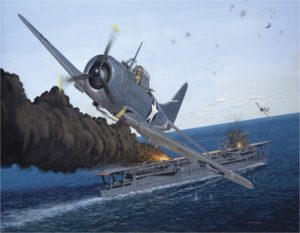The Meaning of Midway
This weekend we celebrate the 75th anniversary of the Battle of Midway fought June 3-6, 1942, one of the most momentous battles in world history and an American victory that shaped the world we live in today. That’s right, it shaped the world we live in today and guaranteed freedom for hundreds of millions of people.
I won’t hold my breath for commemorative media coverage that say, a D-Day or Hiroshima anniversary would garner. In my youth I recall the three major networks remembering Pearl Harbor every December 7th, the way the networks reflect on 9-11 every September 11th (and no other days). We like milestone numbers like 50th or 75th anniversary, or this year’s 100th anniversary of the U.S. entry into World War I. Next year will be the 100th anniversary of the end of World War I, the “war to end all wars” that most in our society have no idea why was fought or even where.
Normandy, or Gettysburg, Yorktown, Fort McHenry, Pearl Harbor…are visited by hundreds of thousands each year featuring modern museums with interpretive displays and tour guides that can bring these battlefields to life for families and schoolchildren in a way that imbues meaning to the sacrifice that occurred there. Normandy was where Europe (western Europe, unfortunately) was liberated from tyranny, and Yorktown was where a fledgling republic broke free to form of government of the people. We can walk the grounds and learn of human stories, inspirational stories of daring and pitched battles, and come away with a greater understanding of our history.
On the other hand, Midway Atoll, where the turning point battle of the Pacific War was fought, is one of the most inaccessible places on earth, 1,000 miles northwest of isolated Hawaii. The atoll, run by the U.S. Park Service, requires special permission to visit and one should expect the first answer to be no. The two main islands (Sand and Eastern) have many buildings (and scars) remaining from that day Japan attacked it on June 4, 1942. The geographic coordinates of where the carrier duel was fought, a patch of water where four Imperial Japanese Navy aircraft carriers and one U.S. flattop were sunk is some 200 miles north of the atoll, a desolate wilderness of water that has nothing but floating plastic debris from Asia and an occasional merchant ship stacked with containers full of trinkets or automobiles for customers on either side of the vast Pacific.
At Midway, the United States turned the offensive Imperial Japanese Navy into a defensive one. By holding and winning at Midway, the Pacific playing field was now even, allowing Roosevelt’s “Europe First” strategy to proceed. It allowed us to land at North Africa later in the year and keep the Germans pinned down there and on their southern and eastern fronts for two years before we could mass forces for D-Day. It had effects on how Soviet Russia behaved, and on how Europe was shaped post-war. It is not a stretch to consider that all of Europe could have fallen under Soviet domination were it not for the American victory at Midway.
Most of this is lost on Americans and I would imagine Europeans. Midway rates a mention in American high school history texts, but only a sentence in the one-paragraph account of the Pacific War, buried under pages of guilt-ridden meanings of atomic destruction at Hiroshima and Japanese internment in California.
Everything is political these days, and that is no less true regarding the inter and even intra-service rivalries of who really won the battle. Without taking anything away from the services and ship and aircraft types that fought at Midway, it is irrefutable that Navy carrier-based dive bombers delivered the killing blows, and Midway is arguably the finest hour for Naval Intelligence and Crypto-analysts. But Navy surface, sub-surface, and aviation communities (Marine aviation, Army Air Corps/USAF) still throw elbows at each other to claim glory. To his credit former CNO Jay Johnson designated each June 4 as a day to remember the meaning of Midway and reflect on a hard won and heroic victory. Unfortunately, because the public cannot visit Midway and due to an unclear message from two if not three armed services, the history and meaning of this pivotal battle are lost to most.
Linked here is a You Tube video of a talk I gave at the National Naval Aviation Museum in Pensacola during the Centennial of Naval Aviation year 2011. Hope you enjoy it and can learn something of the men who fought this remarkable battle and why, and why it is so important to world history. As an aside, today in the local Pensacola newspaper is a listing of classic movies to be shown this summer at the iconic Saenger Theater on Palafox Street. All worthy films, even 1987’s The Princess Bride. The movie Midway, filmed in 1975 on location in Pensacola, the Cradle of Naval Aviation, about the heroic crews who trained in Pensacola and likely viewed shows at the Saenger in the 1930’s, is missing. The editors may be forgiven – nobody taught them about Midway.
